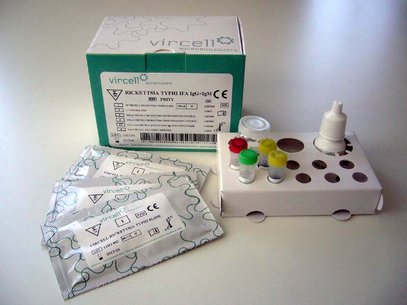New IFA solutions for rickettsial infections
Rickettsioses are a major human health concern in many parts of the world. Rickettsial diseases, which are important causes of illness and death worldwide, exist mainly in endemic and enzootic foci that give rise to sporadic and seasonal outbreaks.
The rickettsiae responsible for human infections are subdivided into three major biogroups: Spotted Fever Group (R. rickettsii, R. akari, R. conorii, R. sibirica, R. australis,R. japonica), Typhus Group (R. prowazekii, R. typhi); and Scrub Typhus Group (Orientia tsutsugamushi).
Most symptoms associated with rickettsial infections are nonspecific (fever, headache, malaise) and require further tests to make an accurate diagnosis. Microimmunofluorescence is recognized as the “gold standard” for the laboratory diagnosis of rickettsial diseases and is used as a reference technique in most laboratories.
As a response to market demands, Vircell has expanded its diagnostic solutions for rickettsial infections with 4 new IFA references for the detection of antibodies against Rickettsia typhi (and other organisms within the Typhus Group), complementing the existing range of IFA products for Rickettsia:
Rickettsia typhi
RICKETTISIA TYPHI IFA IgG + IgM (Ref. PRITY)
RICKETTSIA TYPHI IFA IgG (Ref. PRITYG)
RICKETTSIA TYPHI IFA IgM (Ref. PRITYM)
RICKETTSIA TYPHI IFA SLIDE (Ref. SRITY)
Rickettsia conorii
RICKETTSIA CONORII IFA IgG (Ref. PRICOG)
RICKETTSIA CONORII IFA IgM (Ref. PRICOM)
RICKETTSIA CONORII IFA SLIDE (Ref. SRICO)
Since cross-reactivity within rickettsiae groups hinders the diagnosis to the species level by serological procedures, antibody reactivity to the R. conorii antigen should be considered Spotted Fever group reactive and antibody reactivity to the R. typhiantigen should be considered Typhus Fever group reactive.
Besides, because of extensive cross-reactions among rickettsiae, parallel testing of Rickettsia conorii (Spotted Fever Group) andRickettsia typhi (Typhus Group) should be performed in cases of suspected rickettsiosis. The higher antibody titer against one of these two agents will give a clue about the group to which the causative agent belongs, although diagnosis to the species level should be always performed by direct methods.
For more information on these products, please do not hesitate to contact us.


